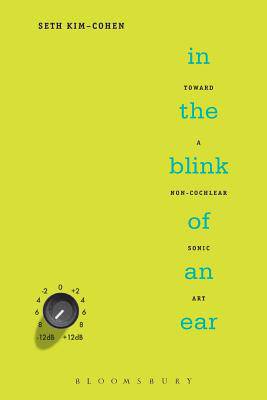
- Retrait gratuit dans votre magasin Club
- 7.000.000 titres dans notre catalogue
- Payer en toute sécurité
- Toujours un magasin près de chez vous
- Retrait gratuit dans votre magasin Club
- 7.000.0000 titres dans notre catalogue
- Payer en toute sécurité
- Toujours un magasin près de chez vous
62,95 €
+ 125 points
Description
An ear-opening reassessment of sonic art from World War II to the present
Marcel Duchamp famously championed a "non-retinal" visual art, rejecting judgments of taste and beauty. In the Blink of an Ear is the first book to ask why the sonic arts did not experience a parallel turn toward a non-cochlear sonic art, imagined as both a response and a complement to Duchamp's conceptualism. Rather than treat sound art as an artistic practice unto itself-or as the unwanted child of music-artist and theorist Seth Kim-Cohen relates the post-War sonic arts to contemporaneous movements in the gallery arts. Applying key ideas from poststructuralism, deconstruction, and art history, In the Blink of an Ear suggests that the sonic arts have been subject to the same cultural pressures that have shaped minimalism, conceptualism, appropriation, and relational aesthetics. Sonic practice and theory have downplayed - or, in many cases, completely rejected - the de-formalization of the artwork and its simultaneous animation in the conceptual realm.
Starting in 1948, the simultaneous examples of John Cage and Pierre Schaeffer initiated a sonic theory-in-practice, fusing clement Greenberg's media-specificity with a phenomenological emphasis on perception. Subsequently, the "sound-in-itself" tendency has become the dominant paradigm for the production and reception of sound art. Engaged with critical texts by Jacques Derrida, Rosalind Krauss, Friedrich Kittler, Jean François Lyotard, and Jacques Attali, among others, Seth Kim-Cohen convincingly argues for a reassessment of the short history of sound art, rejecting sound-in-itself in favor of a reading of sound's expanded situation and its uncontainable textuality. At the same time, this important book establishes the principles for a nascent non-cochlear sonic practice, embracing the inevitable interaction of sound with the social, the linguistic, the philosophical, the political, and the technological.
Artists discussed include: Â
George Brecht
John Cage
Janet Cardiff
Marcel Duchamp
Bob Dylan
Valie Export
Luc Ferrari
Jarrod Fowler
Jacob Kirkegaard
Alvin Lucier
Robert Morris
Muddy Waters
John Oswald
Marina Rosenfeld
Pierre Schaeffer
Stephen Vitiello
La Monte Young
Marcel Duchamp famously championed a "non-retinal" visual art, rejecting judgments of taste and beauty. In the Blink of an Ear is the first book to ask why the sonic arts did not experience a parallel turn toward a non-cochlear sonic art, imagined as both a response and a complement to Duchamp's conceptualism. Rather than treat sound art as an artistic practice unto itself-or as the unwanted child of music-artist and theorist Seth Kim-Cohen relates the post-War sonic arts to contemporaneous movements in the gallery arts. Applying key ideas from poststructuralism, deconstruction, and art history, In the Blink of an Ear suggests that the sonic arts have been subject to the same cultural pressures that have shaped minimalism, conceptualism, appropriation, and relational aesthetics. Sonic practice and theory have downplayed - or, in many cases, completely rejected - the de-formalization of the artwork and its simultaneous animation in the conceptual realm.
Starting in 1948, the simultaneous examples of John Cage and Pierre Schaeffer initiated a sonic theory-in-practice, fusing clement Greenberg's media-specificity with a phenomenological emphasis on perception. Subsequently, the "sound-in-itself" tendency has become the dominant paradigm for the production and reception of sound art. Engaged with critical texts by Jacques Derrida, Rosalind Krauss, Friedrich Kittler, Jean François Lyotard, and Jacques Attali, among others, Seth Kim-Cohen convincingly argues for a reassessment of the short history of sound art, rejecting sound-in-itself in favor of a reading of sound's expanded situation and its uncontainable textuality. At the same time, this important book establishes the principles for a nascent non-cochlear sonic practice, embracing the inevitable interaction of sound with the social, the linguistic, the philosophical, the political, and the technological.
Artists discussed include: Â
George Brecht
John Cage
Janet Cardiff
Marcel Duchamp
Bob Dylan
Valie Export
Luc Ferrari
Jarrod Fowler
Jacob Kirkegaard
Alvin Lucier
Robert Morris
Muddy Waters
John Oswald
Marina Rosenfeld
Pierre Schaeffer
Stephen Vitiello
La Monte Young
Spécifications
Parties prenantes
- Auteur(s) :
- Editeur:
Contenu
- Nombre de pages :
- 296
- Langue:
- Anglais
Caractéristiques
- EAN:
- 9780826429711
- Date de parution :
- 01-07-09
- Format:
- Livre broché
- Format numérique:
- Trade paperback (VS)
- Dimensions :
- 150 mm x 226 mm
- Poids :
- 408 g

Les avis
Nous publions uniquement les avis qui respectent les conditions requises. Consultez nos conditions pour les avis.






